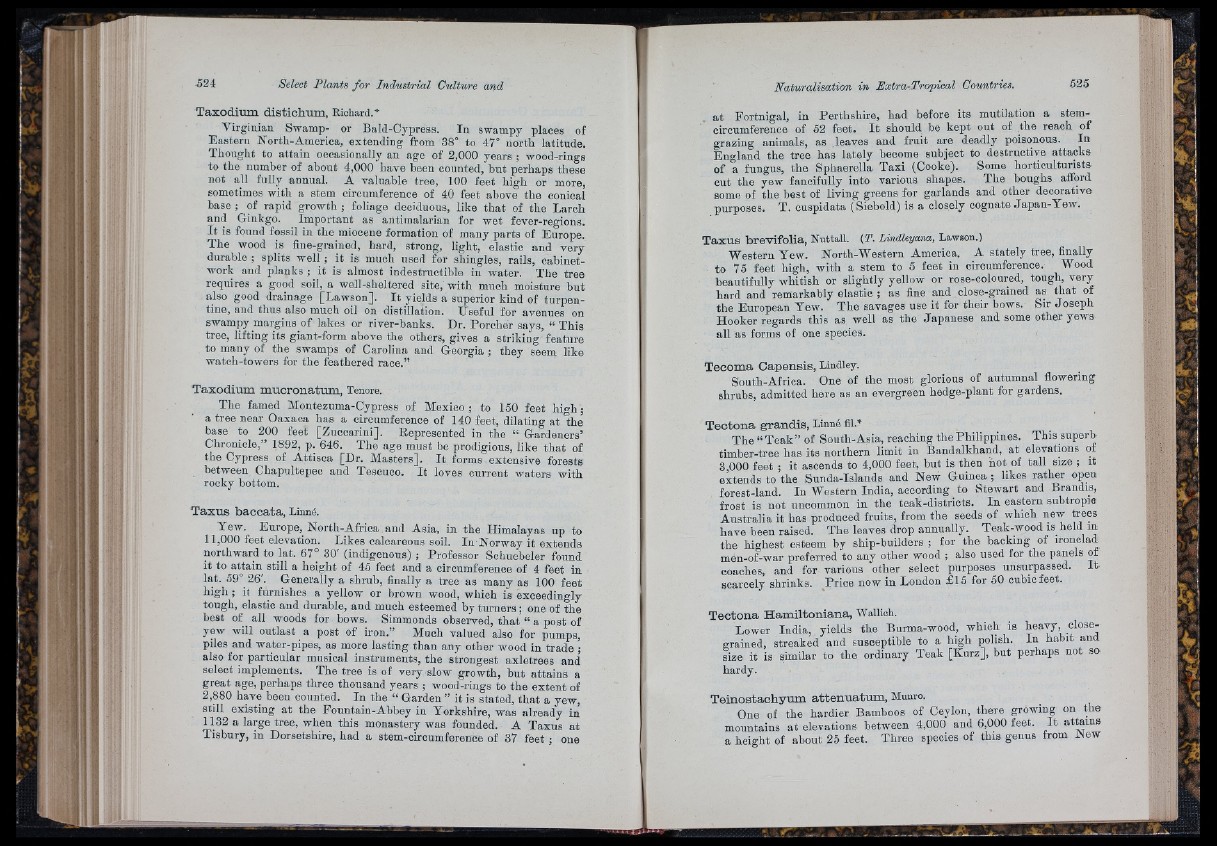
Taxodium distichum, Richard.*
Virginian Swamp- or Bald-Cypress. In swampy places of
Eastern North-America, extending from 38° to 47° north latitude.
Thought to attain occasionally an age of 2,000 years ; wood-rings
to the number of about 4,000 have been counted, hu t perhaps these
not all fully annnal. A valuable tree, 100 feet high or more,
sometimes with a stem circumference of 40 feet above the conical
base ; of rapid growth ; foliage deciduous, like th a t of the Larch
and Ginkgo. ^ Important as antimalarian for wet fever-regions.
I t is found fossil iu the miocene formation of many parts of Europe.
The wood is fine-grained, hard, strong, light, elastic and very
durable ; splits well ; it is much used for shingles, rails, cabinetwork
and planks ; it is almost indestructible in water. The tree
requires a good soil, a well-sheltered site, with much moisture hut
also good drainage [Lawson], I t yields a superior kind of turpentine,
and thus also much oil on distillation. Useful for avenues on
swampy margins of lakes or river-banks. Dr. Porcher says, “ This
tree, lifting its giant-form above the others, gives a striking feature
to many of the swamps of Carolina and Georgia ; they seem like
watch-towers for the feathered race.”
Taxodium mucronatum, Tenore.
The famed Montezuma-Cypress of Mexico; to 150 feet h ig h ;
a tree near Oaxaca has a circumference of 140 feet, dilating at the
base to 200 feet [Zuccarini]. Represented in the “ Gardeners’
Chronicle,” 1892, p. 646. The age must be prodigious, like th a t of
the Cypress of Attisoa [Dr. Masters]. I t forms extensive forests
between Chapultepeo and Tescuco. I t loves current waters with
rooky bottom.
Taxus baccata, Linné.
Yew. Europe, North-Africa and Asia, in the Himalayas up to
11,000 feet elevation. Likes calcareous soil. In Norway it extends
northward to lat. 67° 30' (indigenous) ; Professor Sohuebeler found
it to attain still a height of 45 feet and a circumference of 4 feet in
lat. 59° 26'. Generally a shrub, finally a tree as many as 100 feet
high ; it furnishes a yellow or brown wood, which is exceedingly
tough, elastic and durable, and much esteemed by turners ; one of the
best of all woods for bows. Simmonds observed, th a t “ a post of
yew will outlast a post of iron.” Much valued also for pumps,
piles and water-pipes, as more lasting than any other wood in trade ;
also for particular musical instruments, the strongest axletrees and
select implements. The tree is of very slow growth, hut attains a
great age, perhaps three thousand years ; wood-rings to the extent of
2,880 have been counted. In the “ Garden ” it is stated, th a t a yew,
still existing a t the Fountain-Abbey iu Yorkshire, was already in
1132 a large tree, when this monastery was founded. A Taxus at
Tisbury, in Dorsetshire, had a stem-circumference of 37 feet ; one
a t Fortnigal, in Perthshire, had before its mutilation a stem-
circumference of 52 feet. I t should be kept out of the reach of
grazing animals, as leaves and fruit are deadly poisonous. In
England the tree has lately become subject to destructive attacks
of a fungus, the Sphaerella Taxi (Cooke). Some horticulturists
cut the yew fancifully into various shapes. The houghs afford
some of the best of living greens for garlands and other decorative
purposes. T. cuspidata (Siebold) is a closely cognate Japan-Yew.
Taxus brevifolia, Nuttall. (T. LindUyana, Lawson.)
Western Yew. North-Western America. A stately tree, finally
to 75 feet high, with a stem to 5 feet in circumference. Wood
heautifully whitish or slightly yellow or rose-coloured, tough, very
hard and remarkably elastic ; as fine and close-grained as th a t of
the European Yew. The savages use it for their bows. Sir Joseph
Hooker regards this as well as the Japanese and some other yews
all as forms of one species.
Tecoma Capensis, Lindley.
South-Africa. One of the most glorious of autumnal flowering
shrubs, admitted here as an evergreen hedge-plant for gardens.
Tectona grandis, Linné fil.*
The “ T e a k ” of South-Asia, reaching the Philippines. This superb
timber-tree has its northern limit in Bandalkhand, a t elevations of
3 000 feet ; it ascends to 4,000 feet, hut is then not of tall size ; it
extends to the Sunda-Islands and New Guinea ; likes rather open
forest-land. In Western India, according to Stewart and Brandis,
frost is not uncommon in the teak-distriots. In eastern subtropic
Australia it has produced fruits, from the seeds of which new trees
have been raised. The leaves drop annually. Teak-wood is held in
the highest esteem by ship-builders ; for the backing of ironclad
men-of-war preferred to any other wood ; also used for the panels of
coaches, and for various other select purposes unsurpassed. I t
scarcely shrinks. Price now in London £15 for 50 cubic feet.
Tectona Hamiltoniana, Wallich.
Lower India, yields the Bnrma-wood, which is heavy, close-
grained, streaked and susceptible to a high polish. In habit and
size it is similar to the ordinary Teak [Kurz], but perhaps not so
hardy.
Teinostachvum attenuatnm, Munro.
One of the hardier Bamboos of Ceylon, there growing on the
mountains a t elevations between 4,000 and 6,000 feet. I t attains
a height of about 25 feet. Three species of this genus from New